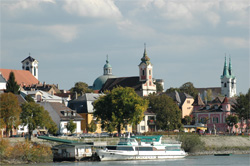Vác
Venue: Calvinist Church (Takács Ádám köz) Access »
Event: 28 August — “Early music on new wave” — J. S. Bach: The Musical Offering »

View of Vác from the River Danube
One of the most attractive Hungarian Baroque cities boasts a past dating back to the Bronze Age. It has been a centre of Catholic faith and a diocesan town for centuries.
The city scape is defined by the cathedral. The foundation of the diocese of Vác is unanimously attributed by historians to the first Hungarian king, Saint Stephen I. The completion of the bishop’s cathedral is also associated with King Géza I and, according to this monarch’s wishes he was burried here. The interior decoration of the cathedral dates from the time of King Saint Ladislaus (László).
The present, late baroque cathedral stands next to the episcopal palace together with the canon palace on the Konstantin Square, which is the ecclesialistical centre of the town.
The historic central area of Vác developed in the early 18th century when the once segregated German and Hungarian districts began to merge with one another while maintaining the original medieval town plan. Today the city is the cultural and commercial centre of the left bank of the Danube bend and the most visited tourist destination.
The Calvinist Church is a listed church in the surroundings of Kisvác (“Little Vác”) mainly inhabited by Calvinists. A restraining statute of Joseph II forbade all non-Catholic churches to have windows overlooking any streets. As for the tower, it was allowed for them only ten years later to build it.
Source: hungarystartshere.com, vac.hu
